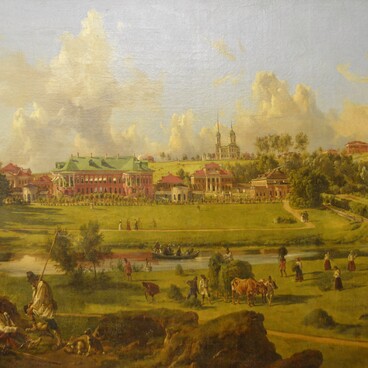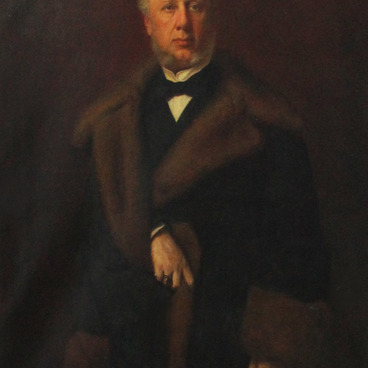The painting ‘Slav Life in the 9th–16th centuries’ was created by artist Ignaty Dashko in the 1930s. Syzran’s Museum of Local History and Lore got it in 1940. The author copied his work from two paintings of the famous Russian Itinerant, academician of the Royal Academy of Arts, Sergey Ivanov (1864–1910): Life of Eastern Slavs (1907) and Bargaining in the Land of Eastern Slavs (1909).
Dashko’s painting combined the two storylines: haggling in the market and peaceful life. The left section of the picture depicts bargaining in the land of the Eastern Slavs: in the background we can see the wooden wall of a small town built on a high and steep river bank. The foreign guest, an Arab merchant in a white loose robe, is sitting cross-legged on the ground. He has brought weapons and jewelry to trade, including red and blue glass beads that the Slavs were especially fond of. This kind of beads are often found in Slav burial mounds.
Next to the Arab, there is a Jewish merchant from Khazaria or from the Arabian East, just like the Arab next to him, both of them being guarded by well-armed warriors wearing body armor who will probably have accompanied the two merchants on their long adventurous journey to the land of the Slavs. Further away we can see merchants from Central Asia, who would have been well aware of the route across the Caspian Sea and up the Volga to the Land of the Khazars, the Bulgarians, and the Slavs. Perching next to them are some customers who, judging by their pointy hats, are steppe dwellers.
Across the merchants we can see Slavs and representatives of the Finnish tribes: They have brought a captive in wooden blocks to sell as a slave, as well as skin and furs of wild animals to sell or trade. In the background is a Viking longship that has just moored. The longship’s owner, a Viking who has just come from the distant Scandinavia, is fixing to step ashore.
The right side of the painting depicts the peaceful life in a Slav settlement. Against a backdrop of a big green forest, a plowed field, and a blue river, we can see local residents going about their day-to-day business: plowing the land, tending to cattle, hunting, and fishing. The basic idea of the artist’s historical paintings is to depict the way the common people lived in these parts, highlight their national traits, and their link with the people who would live in Russia later.
Dashko’s painting combined the two storylines: haggling in the market and peaceful life. The left section of the picture depicts bargaining in the land of the Eastern Slavs: in the background we can see the wooden wall of a small town built on a high and steep river bank. The foreign guest, an Arab merchant in a white loose robe, is sitting cross-legged on the ground. He has brought weapons and jewelry to trade, including red and blue glass beads that the Slavs were especially fond of. This kind of beads are often found in Slav burial mounds.
Next to the Arab, there is a Jewish merchant from Khazaria or from the Arabian East, just like the Arab next to him, both of them being guarded by well-armed warriors wearing body armor who will probably have accompanied the two merchants on their long adventurous journey to the land of the Slavs. Further away we can see merchants from Central Asia, who would have been well aware of the route across the Caspian Sea and up the Volga to the Land of the Khazars, the Bulgarians, and the Slavs. Perching next to them are some customers who, judging by their pointy hats, are steppe dwellers.
Across the merchants we can see Slavs and representatives of the Finnish tribes: They have brought a captive in wooden blocks to sell as a slave, as well as skin and furs of wild animals to sell or trade. In the background is a Viking longship that has just moored. The longship’s owner, a Viking who has just come from the distant Scandinavia, is fixing to step ashore.
The right side of the painting depicts the peaceful life in a Slav settlement. Against a backdrop of a big green forest, a plowed field, and a blue river, we can see local residents going about their day-to-day business: plowing the land, tending to cattle, hunting, and fishing. The basic idea of the artist’s historical paintings is to depict the way the common people lived in these parts, highlight their national traits, and their link with the people who would live in Russia later.



